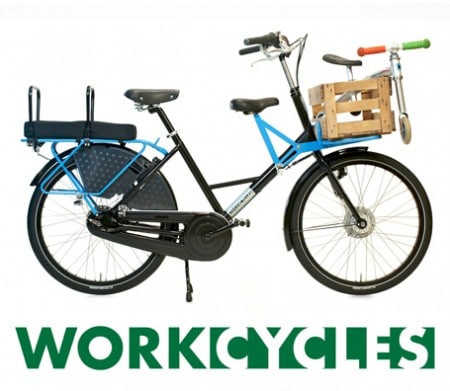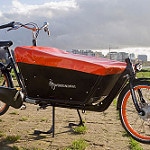Some Americans do “get it”
TweetIf the rather unglamorous background of a Ford Econoline box van with Washington state license plate didn’t give her location away you’d think Jill Keto was in Amsterdam or Copenhagen. WorkCycles Omafiets: check. Personalized with red fenders, basket and flowers: check. Stylishly dressed in heels, skirt and scarf: check. Mobile phone glued to ear: check. Child seat on the rear carrier: check. See Working Girl’s tips for Saving Money.
Her blog Practical Chic (“chic” rhymes with “geek”) and book “Don’t Get Caught With Your Skirt Down” aren’t about Dutch bikes; It’s about living well on a budget, something a lot of people, especially Americans are thinking about right now.
And Jill has a (funny) video about her visit to Dutch Bike Seattle.
Jill and those who think along these lines will get more people on bikes than all the “hairshirt green” martyrs in the world.
Thanks to the tip from Stephan from Dutch Bike Chicago.



















November 27th, 2008 at 22:31
Some Americans have “got it” for over a hundred years. Have you seen this bike in Velorama ?
http://hembrow.eu/personal/velorama.html#whitebike
November 28th, 2008 at 08:03
Haven’t yet been to the Velorama museum, even though there’s a link here. Aside from the lack of modern conveniences that bike looks like a modern, low instep city bike… only much prettier.
If you page through old books and patent applications you find that most of the modern innovations in bicycles have been thought of and probably also done long in the past. I’ve a (American) book from 1896 that shows bikes with two speed cranks, disk wheels, various suspension systems… the list goes on. Of course many of these features couldn’t be effectively produced and marketed until the materials and manufacturing technologies caught up.
November 28th, 2008 at 08:36
What you say about the difficulty of manufacturing is of course true. Many things are invented long before they are practical.
When the copy of Babbage’s Difference Engine in the Science Museum in London was being made (about 20 years ago ?), I went to a presentation by Doron Swade who was doing this. He said then about how parts were being made to high precision using CNC machines and such like, though supposedly no more precision than was available in Victorian times. It would perhaps have been possible to make it back then, but it would have been fantastically expensive, and it’s easier now. BTW, if you like gleaming brass cogs, then this is a very very impressive machine and worth a visit if you’re in London:
https://www.sciencemuseum.org.uk/onlinestuff/stories/babbage.aspx
The same goes for bikes. It’s so much easier to make them precisely now too. That’s a good part of the reason why bikes were very expensive a hundred years ago.
November 28th, 2008 at 08:56
Though I’ve never been formally educated as a machinist I have spent a lot of time around machine shops and factories and studied the basics. I don’t know whether they still do it but the education used to begin with the meticulous preparation of perfect parts with nothing but hand tools. For example students would be required to produce incredibly perfect steel cubes with nothing but hand tools. There have been precision metal workers for centuries: just think about weapons and time pieces.
But the costs were indeed prohibitive. Something like a Shimano Nexus 8 speed hub with rollerbrake could have been made a couple hundred years ago (though ironically not the necessary teflon lined control cables). It just would have cost perhaps a lifetime of earnings for the common man.